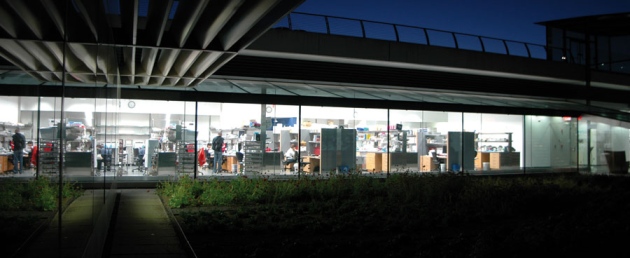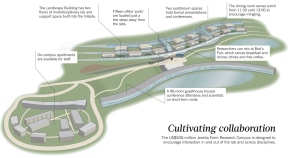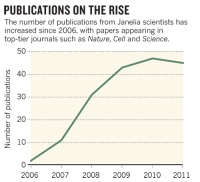O laboratório de U$ 500 milhões.
Esta publicação é para ser divulgada e chegar ao Diretor do CPqGM para incnetiva-lo a construir um desses. Que tal???

The hypothesis is that this $100-million-a-year experiment will produce uncommonly great science. To Rubin, this means being much more than simply excellent. “I'd consider us a failure if, in 20 years, we come back and say, 'We recreated the Salk Institute',” he says, hastening to add that he considers the Salk, located in La Jolla, California, to be one of the best free-standing research facilities in the world. “The point is that we didn't need to build Janelia Farm to do that,” he says.
Esta publicação é para ser divulgada e chegar ao Diretor do CPqGM para incnetiva-lo a construir um desses. Que tal???
Research at Janelia: Life on the farm
Five years in, has a lofty experiment in interdisciplinary research paid off?
Main

The main building of the Janelia Farm Research Campus in Ashburn, Virginia, houses laboratory space within expansive windows and interior glass walls.
M. STALEY/JANELIA FARM
Article tool
Gerald Rubin points to three jumbo coffee urns that stand near a dining area in the Janelia Farm main laboratory building, an elegant ribbon of glass and concrete overlooking the Potomac River valley near Ashburn, Virginia. “We figured it was worth spending $20,000 a year to provide high-quality coffee for free,” Rubin explains, “because that way, people won't be tempted to make it in their labs.”
It is true that the coffee is good. But then, everything about this US$300-million facility testifies to the deep pockets of the Howard Hughes Medical Institute (HHMI), the not-for-profit research-funding organization in nearby Chevy Chase, Maryland, that opened the Janelia Farm Research Campus five years ago as its first-ever intramural research facility.
The hypothesis is that this $100-million-a-year experiment will produce uncommonly great science. To Rubin, this means being much more than simply excellent. “I'd consider us a failure if, in 20 years, we come back and say, 'We recreated the Salk Institute',” he says, hastening to add that he considers the Salk, located in La Jolla, California, to be one of the best free-standing research facilities in the world. “The point is that we didn't need to build Janelia Farm to do that,” he says.
More significantly, the campus embodies what Rubin calls “an experiment in scientific culture”1. Put world-class researchers in an environment that makes it easy to interact across disciplines — right down to chance encounters around the coffee urns (see 'Cultivating collaboration'). Then put them to work on a handful of grand scientific challenges — long-term, high-risk, high-payoff research that addresses some of the biggest questions in neuroscience. And use the HHMI's ample chequebook to free them from the distractions of conventional academic life. No administrative work, no teaching duties, no chasing tenure, no writing of grants. “This really is the ivory tower,” says Rubin, who was named director of the campus in 2003 and has been involved with the facility since its inception.
A geneticist through and through, he has proposed that Janelia must eventually be able to pass the “deletion test”: just as knocking out a gene can reveal its function, removing Janelia from the future scientific landscape should reveal the vital importance of its contributions to biology.
Early days
Five years into Janelia Farm's life, however, Rubin admits that he has no hard evidence that it will ever pass that exceedingly ambitious test. Given the campus's long-term research focus — and the difficulties of creating a brand-new institute from scratch on former farmland — Rubin says that he does not expect the facility to start producing its best discoveries for another five or even ten years. So far, the experiment has proved only that the promise of well-financed, unfettered academic freedom can indeed entice high-quality researchers to move to a new facility.
Still, the researchers' presence is reflected in the steady increase in publications from Janelia Farm labs (see'Publications on the rise'), and in the growing respect Janelia is commanding from investigators who were initially sceptical of its lofty ambitions.
Getting even this far has been a major accomplishment, says Eric Kandel, a neuroscientist at Columbia University in New York who was one such sceptic. “No one has hit a home run yet,” he says. “But the team is in place.”
The idea behind Janelia Farm originated in 1999, when Thomas Cech, a biochemist at the University of Colorado in Boulder, had just agreed to become president of the HHMI and was looking to try something new. The HHMI was already funding hundreds of investigators at universities around the world. And with its endowment booming, Cech thought there must be some way for the organization to have a bigger impact on science than just funding a few hundred more. To help him work out how to do this, he recruited Rubin, then a geneticist at the University of California, Berkeley, as HHMI vice-president for biomedical research.
Rubin began by looking back at some of the wonderful experiences in his own career: summers as an undergraduate at the Cold Spring Harbor Laboratory in New York; a PhD at the Medical Research Council Laboratory of Molecular Biology (LMB) at the University of Cambridge, UK; and three years at the Carnegie Institution for Science Department of Embryology in Baltimore, Maryland. He wondered: what had made these places feel so great?
Rubin posed the question to many people, including veterans of non-biological institutes — notably Bell Labs in Murray Hill, New Jersey, which had been an innovation powerhouse before the 1984 break-up of its parent company, AT&T. The answers from all these places were surprisingly consistent, he says. Research groups were small, which promoted communication and mentoring. Group leaders were active bench scientists, not administrators or fund-raisers. Research was funded from within, so there was no need to chase grants. And no one got tenure, so that researchers could rotate through and ideas could stay fresh.
Many institutes had implemented some of these principles. Bell Labs and the LMB, despite widely divergent remits in applied physics and molecular biology, had implemented all of them in their glory days. But no one was doing so at the time, says Rubin — especially not the internal-funding part. And that, he argued, was the HHMI's great opportunity.
Cech and the HHMI trustees were sold on the idea from the beginning. But others were not. “I didn't see what was so special about recreating the LMB,” says Kandel, recalling his early scepticism. “It wasn't clear to me what problems would be solved there, or even what fields they would be working in,” he says. Many university investigators funded by the HHMI worried that this new initiative would end up cutting into their money. And most of them doubted that the HHMI would be able to persuade top-quality people to forgo tenure in established research centres and move to a farm outside Ashburn, a dormitory suburb an hour's drive from Washington DC.
Also controversial was the initiative's proposed research strategy of focusing on a handful of grand challenges instead of tackling a wide range of biomedical problems. In 2004, the HHMI held a series of five workshops to determine what those grand challenges would be. One topic they settled on fairly quickly was technologies for biological imaging. “It was a great problem for us,” says Rubin. Not only would it bring together physics, chemistry, biology and many other disciplines, he says, “it was going to be an enabling technology for so many areas, the way [DNA] sequencing had been”.
A second major topic was understanding neural circuits and how they give rise to behaviour. This promised to fill a tremendous gap in neuroscience, says Kandel. “It was clear that we now understood neurons very well,” he explains. “And we had imaging techniques to see how large areas of the brain are interconnected. But there was nothing to link the two.” A new generation of techniques was poised to aid in this quest — most notably optogenetics, in which the activity of specific neurons can be tracked and manipulated using light, allowing researchers to work out the function of those neurons and how they connect.
But at the time, the application of optogenetics to neuroscience was still in its infancy. And there was always the chance that Janelia Farm researchers would spend 20 years deciphering the neural circuitry of, say, the fruitfly Drosophila melanogaster, only to discover that it had nothing to do with the human brain. Most people thought that the underlying principles and logic of the circuits would have been conserved throughout evolution, says Kandel, but still, “it was a very ballsy move”.
Fertile soil
In October 2006, the HHMI officially opened Janelia Farm's main laboratory facility, dubbed the Landscape building for the way it winds for some 300 metres along the vast, open 'S'-shaped curve of a hillside. It's not exactly a warm and cosy place. The hallways on the upper two floors, where the inner glass walls open onto row upon row of laboratory benches, are so big and full of light that they feel a bit like airport concourses. They also seem to be constantly vanishing around the next bend, which can produce the disconcerting sense that one is stepping off into infinity.
But none of that bothered Julie Simpson when she arrived in the summer of 2006, fresh from a postdoctoral appointment in neuroscience at the University of Wisconsin–Madison. She had been eager to get to Janelia Farm ever since hearing Cech give a talk about its philosophy — so eager, she says, that when she moved in, “I had to wear a hard hat because they didn't even have finished floors in my lab yet!”
And she hasn't been disappointed. “I really like being part of a community focused on a particular problem,” she says. “Every talk is relevant, and every colleague is interested in the same basic thing” — albeit with different perspectives and lots of productive arguments. Simpson leads a group using optogenetics to trace the neural circuitry that gives rise to specific, hard-wired responses — grooming behaviour, for example — inD. melanogaster. Comparing the detailed structure of many such circuits, she says, should begin to reveal the general principles behind them2.
Another early recruit was Eric Betzig, a physicist who had begun working at Bell Labs during the late 1980s, when the facility was still investigating everything from neuroscience to antimatter. Impatient with the steadily declining role of basic research at the labs, Betzig left to work at his father's machine-tool company in 1994. Soon after deciding to get back into research, he joined Janelia Farm in 2006 to work on a broad range of imaging technologies.
“What attracted me was the same thing that had attracted me about Bell,” he says. “All the resources you need, and no pressure to publish. I won't do science if I can't do it under those terms.” Before arriving at Janelia, Betzig had been developing an imaging technique, called photoactivated localization microscopy, or PALM, that he created in collaboration with Harald Hess, a physicist who is now also at Janelia Farm. It uses image-processing algorithms pioneered by astronomers to detect the position of single fluorescent molecules with nanometre accuracy3. Since starting at Janelia, Betzig has developed three more imaging techniques designed to help biologists peer deeper than before into the layers of living cells, with higher resolution and with less damage to them in the process.
Janelia Farm is definitely not for everybody, says Rubin. “I've tried to make it irresistible for a small fraction of people,” he says — researchers who are confident enough to go without tenure, who don't mind the remote location or the six-person limit on group size, and who do want to work with their own hands.
Plenty of researchers do seem to fit that description. At present, Janelia Farm has 20 research-group leaders, who are evaluated for renewal on a five-year cycle. The first round of evaluations begins next spring — a process Simpson calls “terrifying”, if only because it's new and no one knows for sure how it will work. In addition, 26 fellows at various stages of non-renewable five-year stints are working at the facility, as are more than 100 visiting scientists. With additional group members and support staff, the total number of employees at Janelia Farm comes to 424.
Yet the place can still feel almost empty. “That's the first thing you notice,” says Robert Tjian, a biochemist who was once Rubin's colleague at Berkeley and who succeeded Cech as HHMI president in 2009. “We probably have another 100 to 150 scientists to put in the building before it's even close to being full.”
Keeping creative
Those spaces are empty in part because it has taken longer to recruit scientists than Rubin initially thought. The most common problem for prospective recruits is the six-member limit for research groups, he says. The remote location has been a smaller hurdle than feared, but it has been a factor.
Rubin and his colleagues have done their best to fight that isolation. Janelia's visitor programme brings scientists in for weeks or even months at a time, and the campus hosts about a dozen scientific conferences every year. Nonetheless, the remoteness of the campus is a major ongoing challenge, says Carla Shatz, a neuroscientist who directs the interdisciplinary Bio-X programme at Stanford University in California, and who serves on the Janelia Farm advisory committee. “Janelia has to think about how it can create excitement and creativity and innovation in a location that doesn't have ready access to a medical school, an engineering school, biology, physics and chemistry departments or an undergraduate student body,” she says.
A related challenge is that of keeping the research programme intellectually fresh. The tight focus on imaging and neurocircuitry has been useful in the initial phase, says Tjian, “so that everyone understood what Janelia Farm was”. But in the long run, he says, the place will stagnate unless it can broaden out and give scientists the freedom to follow new opportunities as they arise.
That is another reason Janelia still has so many empty spaces: they allow for expansion. On the basis of a series of planning workshops held earlier this year, Rubin has begun to hire group leaders in the fields of cell biology, evolutionary biology, structural biology and chemistry — each of which has some overlap with neurocircuitry but will also extend the campus's programme in new directions.
Looking back over Janelia Farm's first five years, Rubin says he is very satisfied. “We showed that we could go from an empty building to a functioning lab, that we could hire first-rate people, and that they could come here and work on interesting problems,” he says. “All the things people said we were certain to fail at, we accomplished.”
But what happens next? Can Janelia Farm do 'great science' during the next 5 to 10 years? Will it pass Rubin's deletion test? Can it rewrite the introductory biology texts (Cech's favourite definition of great science), or foster “a couple of programmes that create a whole new direction” (Tjian's favourite)?
That is the great unanswerable question. As Simpson says, “you can't engineer great science. You just have to create the conditions that make it possible, and see what happens.”
- Nature
- 479,
- 284–286
- ()
- doi:10.1038/479284a
- See Careers page 433



Nenhum comentário:
Postar um comentário